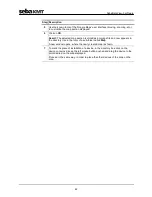
Programming the logger using the SebaDataView-3 software
52
Step Description
3
Query the current configuration of the logger.
(This step is not absolutely necessary in all cases, but it is recommended to
nevertheless always perform the step instead of skipping it.)
If you want to read the data directly from
the device via radio, click on
Read
.
If you want to download the data from
the FTP server, click on
Read settings
.
Result: The current configuration data is
read out and displayed.
All input fields are now editable.
Result: The current configuration data is
download and displayed.
All input fields are now editable.
4
Enter or change the configuration data
(see next sections).
Change the configuration data (see next
sections).
5
Finally, click on
Program
.
Finally, click on
Write settings
.
Result:
The new configuration data is
transmitted via radio to the logger and
installed there.
Result:
The new configuration data is
upload to the FTP server. From there, it
is downloaded by the logger at the next
planned contact and then installed on
the device.
You find detailed information about the necessary programming steps in the following
sections.
8.2
Status of the device
In the
State
segment current status information about the device can be found, such as
the firmware version used, the internal time, battery status etc.
The
Resulting storage periode
line indicates how long the device can continue to
measure with the currently set parameters until the device memory is full.
8.3
Selecting the logging interval
You can select the time interval in which the measured values are logged from the
Log Interval
drop-down list.
8.4
Configuring a measuring channel
Depending on its configuration, up to 4 sensors can be connected to a logger. In order
to evaluate the logged data in the right way, the logger needs to know which type of
sensor is connected to which channel.
Make sure that the sensor configuration is consistent with the effective connection
setup. Each channel is linked with specific wires of the VK86 connection cable (see
page 29).
Please pay regard to the fixed channel allocations (see page 27) when configuring
internal pressure sensors or sensors with current output.
Make sure you enter the values in the same format as shown in the figures.
Introduction
Summary of Contents for Sebalog D-3
Page 2: ...Consultation with SebaKMT 2...
Page 8: ...Terms of Warranty 8...
Page 26: ...Commissioning the logger 26...
Page 34: ...Connecting the logger and installing it on site 34...
Page 70: ...Programming the logger using the SebaDataView 3 software 70...
Page 78: ...Retrieving and evaluating data 78...
Page 88: ...Changing the battery 88...






























